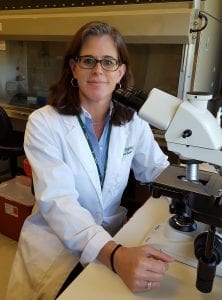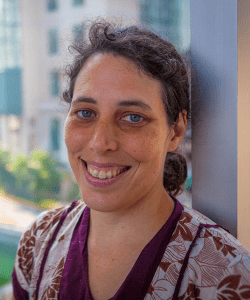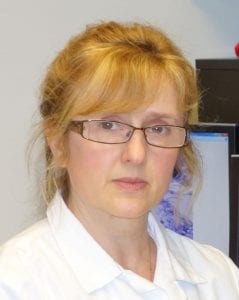Women in STEM leading Lyme disease research

Recently there has been a significant increase in technological advancements in Lyme research, and we have a lot of women to thank for that.
In honor of Women’s History Month, LymeDisease.org salutes some of the women in STEM (science, technology, engineering, mathematics) who are trailblazers in Lyme and tick-borne disease research.
Monica E. Embers, Ph.D.
Division of Bacteriology and Parasitology
Tulane National Primate Research Center
Dr. Embers is an Assistant Professor in the Division of Bacteriology and Parasitology at Tulane University. She holds a doctorate degree in microbiology and immunology. The focus of her research is on Lyme disease pathogenesis, antibiotic efficiency and developing a test that is capable of differentiating between active infection and cure. She has authored over 80 scientific publications with the most recent providing evidence that Borrelia bacteria are able to survive a standard 28 day course of antibiotics in primates.
Do you have Lyme disease? Use our symptom checklist today.
Deanna Needell, Ph.D.
Department of Mathematics
Univ. of California, Los Angeles
Dr. Needell is a professor of mathematics at UCLA. She specializes in big data analytics and artificial intelligence techniques. She has authored over 70 scientific journal publications. Recently she received an $800,000 award from the National Science Foundation to develop a novel mathematical technique to analyze the large amount of data collected from LymeDisease.org’s patient registry, MyLymeData.
Jennifer Mankoff, Ph.D.
Dept. Computer Science & Engineering
University of Washington
Dr. Mankoff is a professor of computer science and engineering at the University of Washington. Previously, Mankoff taught at Carnegie Mellon University’s Human Computer Interaction Institute. Her published research includes over 170 papers and includes a number of studies focusing on the quality of life for patients with Lyme disease and how Lyme disease patients use online information. Most recently, her work has focused on 3D printing and its potential for creating personalized assistive technologies for people with disabilities.
Jennifer C. Miller, Ph.D.
Director of Research and Development
Galaxy Diagnostics, Inc.
Dr. Miller holds a doctorate in microbiology, immunology, and molecular genetics and has spent the past 20 years studying vector-borne and zoonotic pathogens including Borrelia burgdorferi. She leads the clinical assay and diagnostic tests portfolio development at Galaxy Diagnostics. Previously, Dr. Miller served as an assistant professor of microbiology at North Carolina State University. She has published more than 25 peer-reviewed scientific articles. Her current research focuses on the mechanisms driving Lyme arthritis, with the goal of developing better treatments.
Eva Sapi, Ph.D.
Dept of Biology and Environmental Science
University of New Haven
Dr. Sapi directs the Lyme Disease Research Program at University of New Haven. To date, over 90 graduate students have received training in Lyme disease-related research through her program. She holds a doctorate degree in molecular biology and genetics and has published over 70 peer-reviewed scientific papers on the topic of Borrelia, how it forms biofilm and the mechanisms by which it evades the immune system. Her most recent research has focused on finding antimicrobial agents that are effective in killing Borrelia in culture.
Jyotsna Shah, Ph.D.
President and Laboratory Director
IGeneX Clinical Laboratory
Dr. Shah holds a doctorate degree in diagnostic immunology and brings over 40 years of research experience in immunology, molecular biology and microbiology. She has 48 peer-reviewed publications. She is credited with starting the first DNA sequencing laboratory in E. Africa and has become a world expert on use of Fluorescent in Situ Hybridization (FISH) technique for direct detection of pathogens in clinical samples. Recently, she has focused on the development of diagnostic tests that detect different strains of Borrelia and Relapsing Fever.



























Thank you for your research in the treatment of Lyme Disease. I never thought a little bug could put me down. I have had Lyme, Anaplasmosis and Babesosis.and still suffering. Please keep up your good work.
Thank you all we need hope 28yrs is along time to be sick
Thank you to all who realize all that needs to be accomplished to help those who struggle everyday with the affects of Lyme. I never knew what it could do to your life until I woke up one day with the bullseye rash and my world changed forever. These women give me hope.
Thank you ladies. I am 40 years living on lyme thyme and figured this complicated disease constellation that has consumed my once active life will not end well. It is nice to know the coming generations will not suffer alone and hopeless while govenmental agencies line their pockets and distract the public with coverups and untruths.
I can’t express the gratitude that I feel knowing there are actual doctors out there that believe in Lyme and it’s lingering effects. It is time to stop the suffering. Thank you!
Thank you! Thank you! Thank you! You are helping to give us a future. I’ve been almost completely disabled for the entire length of my preteen kids’ lives. They need you as much as I do! Thank you
Have 3 sons who have it and still no relief.
Thank you for your generous commitment to this mysterious disease. Many of us continue to learn everyday how to live with Lyme.
Thank you and God bless you for all you are doing to help us. No one should ever have to go through this disease, never mind all the bureaucracy that goes along with having Lyme
My name is Phillip and I am an Australian living in Malaysia.
Like the all of the other people leaving comments I to woke up with a bulls eye red rash on one of my fingers which was put there by a tick under the collar of my dog who I was trying to restrain from running onto the road. It was painful for quite some time and I did suspect it was some sort of an insect bite but unfortunately left it a bit too long before. I discovered an article about tick bites and the need to take a course of antibiotic immediately. Doctors and Vets whom I talk to in Malaysia seem to think that Lime Disease hasn’t reached Malaysia yet because they tell me it needs a sand fly vector as well?
All I know is I do not feel so good and I have numbness in my toes and sometimes dizziness?
Like everyone else I am praying for all of you good ladies who are doing research into a cure for Lime Disease.